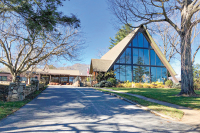Wildlife Commission OKs elk hunting rules
 Elk hunting could be on the way to becoming legal in North Carolina following the N.C. Wildlife Resource’s Commission unanimous vote in favor of a rule change last week, though any actual season on elk is likely still a good ways in the future.
Elk hunting could be on the way to becoming legal in North Carolina following the N.C. Wildlife Resource’s Commission unanimous vote in favor of a rule change last week, though any actual season on elk is likely still a good ways in the future.
“There’s been a significant amount of requests from private landowners and sportsmen in Western North Carolina to work on instituting an elk hunt at some point in time, and the public comment at our public hearing was overwhelmingly in favor of an elk hunt,” said Neal Hanks, of Asheville, the Wildlife Commission’s representative from the western part of the state. “However, the commissioners didn’t feel like with the population at this point that it would be a sound decision to issue permits yet.”
So, along with the rule — which removes elk from the state’s list of species of special concern and allows for a permit-only hunt during the month of October — the Commission adopted a resolution pledging to delay issuing any elk hunting permits until all the wildlife managers involved agree that the population’s big enough to warrant it. It’s been just 16 years since a herd of 52 elk was reintroduced in the Great Smoky Mountains National Park following more than 200 years of extinction from the area, with the herd now estimated at 150 to 200 animals.
“We’re going to continue to monitor the situation and make sure we have good counts on the herd, and when the population reaches a sustainable level we’ll start issuing a limited number of permits,” Hanks said.
An elk working group, consisting of representatives from the Wildlife Commission, the Great Smoky Mountains National Park and the Eastern Band of Cherokee Indians, has been meeting regularly since the reintroduction to discuss management strategies and issues facing the elk. Each of the three entities has its own respective jurisdictions for land management, but because the same elk move between park, state and tribal land, collaboration is key.
Having the resolution in place alleviates the main reservation that Justin McVey, district biologist for the N.C. Wildlife Resources Commission, had about the hunting rule.
Related Items
“It kind of ensures we will base this decision off of science and the actual numbers of elk,” he said.
Once the numbers got to a place where an elk season — likely, a very limited one with just a few permits available — seemed feasible, the Wildlife Commission could decide to allow permits to be granted.
“It will be done based on input from all the stakeholders,” Hanks said. “Our process is a very open one.”
While the elk hunting rule did garner wide support, that support was not universal. Statewide, 211 of the 284 people who attended the Wildlife Commission’s public hearings on its proposed 2016 rule changes and submitted a card expressing their position on the various changes presented said they were in favor of setting up the framework for an elk hunt.
Among those who attended the District 9 hearing in Haywood County, the margin was much tighter. Overall, 120 of the people who attended the meeting submitted a card. Of those, 78 were for the elk-hunting framework and 42 were against it.
Some, like Haywood County resident Sarah Wendell, expressed caution based on the elk’s past extinction in North Carolina, largely due to overhunting.
“This seems to be history repeating itself if we do not allow these creatures to roam free without fear of being hunted,” Wendell said.
“Knowing that some hunters go for the big and the best, that is going to affect the health of the herd to have people go for the healthy ones, so I am opposed to this elk hunt,” agreed Henderson County resident Grace Shun, expressing concern with a hunting season that would overlap with breeding.
But by and large, wildlife officials and wildlife supporters seem to be in favor of the Wildlife Commission’s decision.
“We support hunting, we support habitat work, we support making sure the habitat is there,” said Kim Delozier of the Rocky Mountain Elk Foundation. Delozier, a former biologist for the Smokies, was instrumental in the original elk reintroduction in 2001.
“I think the decision is sound,” said Ben Prater, regional director for Defenders of Wildlife. “Obviously folks voiced concerns, and I think those concerns were very legitimate. We have a relatively small herd. The decision before the commission this time was really to think about putting a new tool in the toolbox for elk management.”
The amount of time needed to get the herd from where it is now to a point where it could sustain a limited hunting season is unknown, with numbers from two to five to 10 years spit out depending on who you ask. A host of variables could end up affecting the final count, as a variety of forces affect population levels. For instance, reproduction, habitat quality and deaths — whether by automobile, disease or angry farmers. A recent episode in Haywood County that left four elk dead (see related story) has that last one sticking in Hanks’ mind.
“If large numbers of those are killed in that fashion, it’s going to have an impact on the herd and whether a traditional hunt would ever be an appropriate thing to do,” he said.









